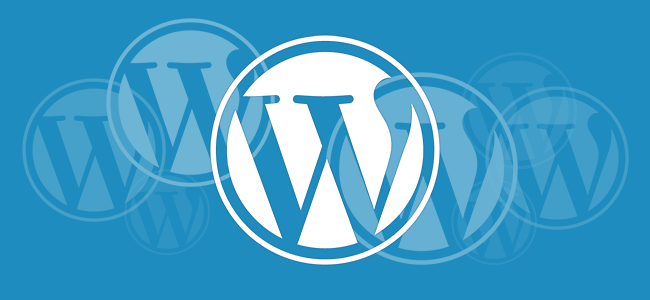Since WordPress 3.0 ha existido la opción oculta de convertir su Blog en una instalación de WordPress de sitios múltiples. No se trata de algo que la mayoría de los blogs realmente requieran y seguramente no es para los débiles de corazón. A pesar de todo, es algo que puede ser realmente útil para los sitios Web que desean dividir su contents en canales individuales.
Before considering converting your blog to a multi-site facility, you should carefully consider why you want to do so. Installation will involve a bit of technical work and maintenance is a bit more complicated than using a single blog.
Regardless, if it's something you want to do, let's go through the process.
Why would you use multiple sites?
As I briefly mentioned, there are a number of reasons why you would convert your website from a single blog to a multi-site website.
Es una excelente manera de permitir que los equipos y / o empleados de su compañía tengan sus propios blogs pero que formen parte del mismo domain de la compañía. Puede usarlo para brindarles a las persons distintas plataformas en las que trabajar fuera del blog principal de su sitio que puede ser para noticias oficiales.
Al mismo tiempo viene con el beneficio adicional de estar controlado de forma centralizada por un Username Super Admin y le posibilita compartir temas y complementos en varios blogs.
Alternatively, you can turn your website into something like WordPress.com for your users, allowing them complete individuality while maintaining strict control of system administration and security.
The joy of using multiple sites is that each site you create can be completely different without going through the hassle of installing WordPress multiple times or adding multiple databases. That, in a nutshell, is the key selling point.
Set up multiple sites
Setting up multiple sites can be challenging, but it's straightforward if you know what you're doing (that's why you're reading this!). Requires adding multiple code snippets in your wp-config.php archivo y su server Web .htaccess proceedings.
The WordPress Codex has a complete guide on creating a network version of WordPress.
Ya que está convirtiendo un sitio web existente, debe utilizar la opción de subdomain para varios sitios. Esto se debe a problemas de enlaces permanentes existentes. El equipo de WordPress está investigando formas de evitar esto, pero por el momento eso significa que sus blogs de sitios múltiples usarán una estructura de Url de blog1.mydomain.com y blog2.mydomain.com.
Now before proceeding, take a full backup of your WordPress installation. You want a copy of the database and files in case something goes terribly wrong so you can roll back smoothly.
Now that you have a backup, it's time to get started.
The first thing to do is download a copy of your wp-config.php and .htaccess archivo a su computadora usando un programa FTP how FileZilla.

Una vez que los haya guardado localmente, ábralos con su editor de texto favorito. El archivo .htaccess puede estar oculto, por lo que deberá configurar sus opciones de visualización para incluir archivos ocultos. Puede encontrar información acerca de cómo hacer esto en la ayuda de su sistema operativo o por medio de una búsqueda rápida en Google.
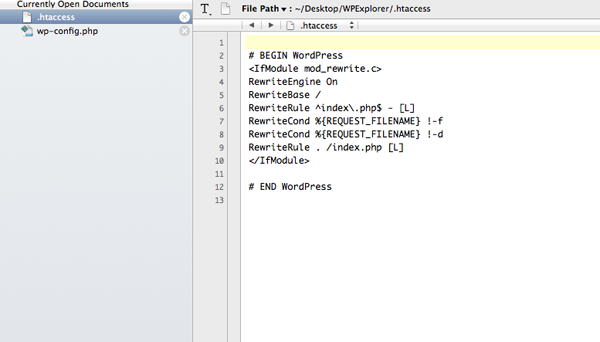
Now we need to edit the local wp-config.php proceedings. Add the following code snippet above the first line that begins with demand or include:
/ * Multisite * / define ('WP_ALLOW_MULTISITE', true);
Once you've made the change, load the wp-config.php en su servidor web, sobrescribiendo la versión anterior. Cuando se haya cargado el archivo, inicie sesión en el Panel de administración de su sitio web. Antes de poder continuar, deberá desactivar todos los complementos que haya instalado. Se pueden reactivar una vez que se complete la conversion de varios sitios.
Once you have disabled the plugins, look for Tools> Network Settings.
In this section, you choose your network name and the email address of the network administrator. Click Install on pc when you've made those decisions.
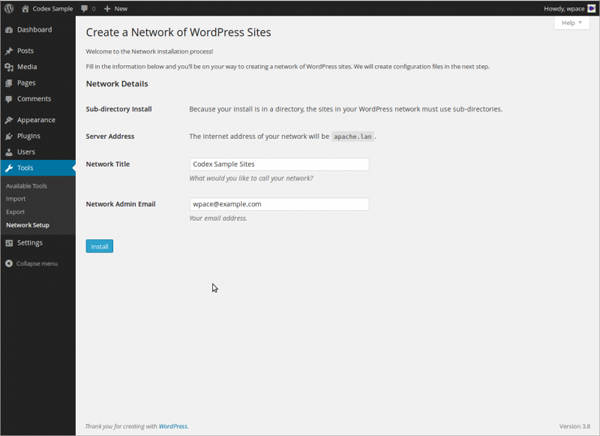
Next, you are provided with a code specific to your site to insert into the wp-config.php and .htaccess records. Follow the instructions and add this code to the local versions of the files and then upload them to your web server, overwriting the existing files.
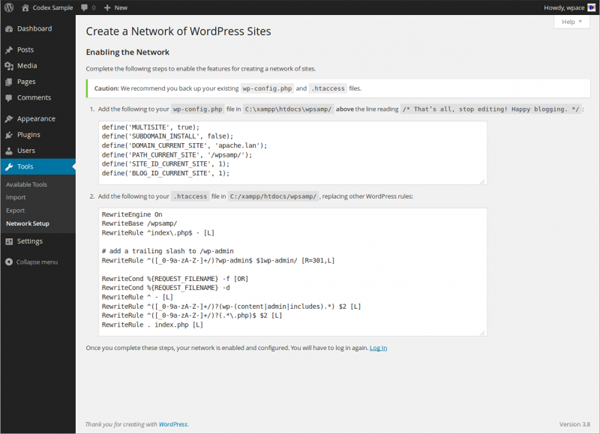
One thing that should be noted is that the code required for the wp-config.php it should be placed before the first line that begins with require or include just as it was with the previous code addition.
Una vez que haya completado estos pasos, deberá volver a iniciar sesión en el Panel de administración. Puede que be necesario quitar la memoria cache from his browser para que esto funcione correctamente. Este es ahora el Panel de control de red y una vez que haya vuelto a iniciar sesión, debería haber un nuevo elemento en la barra de menú en la parte de arriba de la pantalla. Donde antes estaba el nombre de su sitio ahora debería mostrarse como My sites.
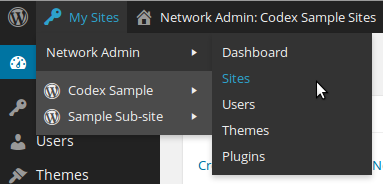
Here you can reactivate all your plugins as network activated plugins and installed themes as network activated themes. That means they will be available for use with every site you create in this multi-site installation. This is at the same time where you will add new plugins and themes in the future so that you can use them on each site if you wish.
Creating a new site
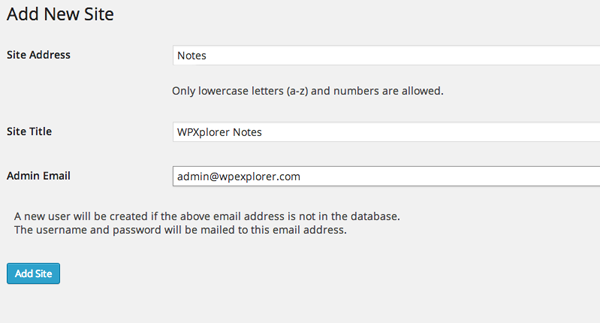
Now that you have set up your WordPress multi-site installation, you can now add new sites to the network. This is done in the Network Management Panel by clicking on Sites> Add New.
Then simply give the site a name and title and add the email address of the admin user. If this address is not yet associated with a user, a new user is created.
Como se trata de una conversión a varios sitios y utiliza las opciones de subdominio, deberá agregar la entrada del subdominio en el DNS de su sitio que coincida con el nombre de su nuevo sitio. Si puede agregar esto unos días antes, las cosas serán mucho más fáciles para usted. Si aún no ha agregado esto a su DNS, debe hacerlo ahora antes de esperar unas 48 horas antes de continuar.
Once the DNS has been updated, you can log into the new site dashboard and start creating your content and managing site plugins and themes as you would for any new WordPress installation. You don't have to use all the plugins or even the same theme as the main site.
You can repeat the steps above to add as many new sites as you want.
Converting an existing website to a multi-site installation comes with some additional clean-install issues, but it's a great way to add additional channels of content to your domain.
The limitation of having to use subdomains for your sites is the only real problem when converting an existing website. If you prefer to have your websites as folders at the end of your domain, you'd better create a new WordPress multi-site installation and import your existing website into it.
This operation requires a post of its own that we can deal with at a later date.
Do you use multisite WordPress? Did you choose to convert an existing website or did you just start over with a clean install? We'd love to hear about your experiences with multiple sites and any boards of directors for running a WordPress network in the comments below.

